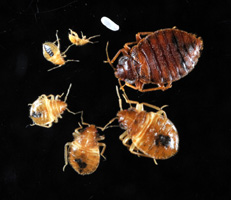
Know The Facts: Bed Bugs
Click here for the most common bed bug questions.
Click here for the most common bed bug questions (this site is in Portuguese).

Videos
Bed Bug Prevention &Control Video - 20 min
Nat Geo Bed Bug Introduction
Bed Bug Biting Signs
Bed Bug Feeding Sequence
Hotel Room Inspection
Avoid Bringing Bed Bugs Home
Bed Bug Dog Detection
Bed Bug Infested Suitcase
Bed Bug Control - Steaming
Bed Bug Control - Spraying
Bed Bug Control - Encasement

Resources
Extension Entomology,Purdue University
Purdue University, Medical Entomology - Bed Bugs
EPA | Controlling Bed Bugs
Bed Bug Product Search Tool
Bed Bug Insecticide application target areas, key ingredients and formulations
Additional Resources
Powerpoint Presentations
Basics
Prevention & Detection
Control
Bed Bug Exhibit
Bed Bug Inspection Game
Armed Forces Technical Guide
Purdue Scientific Publications
Bed Bug Identification
Correct identification is the first step in managing insect pests. In some situations, bed bug look-a-likes may be present and confuse the issue. The presence of current (or recently eradicated) bat infestations may be cause to have the bugs positively identified. Bat bugs are closely related and appear very similar to bed bugs.
What do bed bugs look like?
Adult bed bugs are approximately 1/4" long and are red-brown in color. They are similar to the size, shape and color of an apple seed except that they are very flat (if they have not eaten). They have very thin legs and antennae and have no wings. Immature bed bugs are similar to adults, except that they are smaller and are a lighter yellow-brown in color.
Submitting Physical Specimens for Diagnosis
This site provides descriptions and photographs of bed bugs, however, if you would like to have a positive identification, Purdue University is pleased to perform this for you.
Please visit the Purdue Pest Diagnostic Lab for information on what, how, and where to submit your sample. Physical Sample Submission Form PPDL-1-W can be downloaded from the PPDL site. Please print and mail with your sample.
If you wish to submit both a physical sample and digital images of the insect, please be sure to NOTE in the Additional Information area on BOTH the physical form and the digital form that you have submitted both physical and digital images so that you will not be charged twice for the same sample.
How to Collect and Sample Specimens
Submitting Insect Specimens
Collect fresh specimens. Send a several if possible. Care should be taken to package insects so that they arrive unbroken. Package in a sturdy crush-proof container and pack with additional paper to prevent shifting.
Bed bugs should be submitted in a small leak-proof bottle or vial of 70 percent alcohol. Rubbing (isopropyl) alcohol is suitable and readily available. Do not submit insects in water, formaldehyde or without alcohol as they will readily ferment and decompose. Do not tape insects to paper or place them loose in envelopes.
Ship in crush-proof container immediately after collecting.
Provide information detailing where they are found and what questions you would like to have answered. Incomplete information or poorly preserved specimens may result in an inaccurate diagnosis or inappropriate control recommendations. Badly damaged specimens are often unidentifiable and additional sample requests can cause delays.
Ship sample to:
Plant and Pest Diagnostic Laboratory
LSPS-Room 101, Purdue University
915 W. State Street
West Lafayette, Indiana 47907-2054


